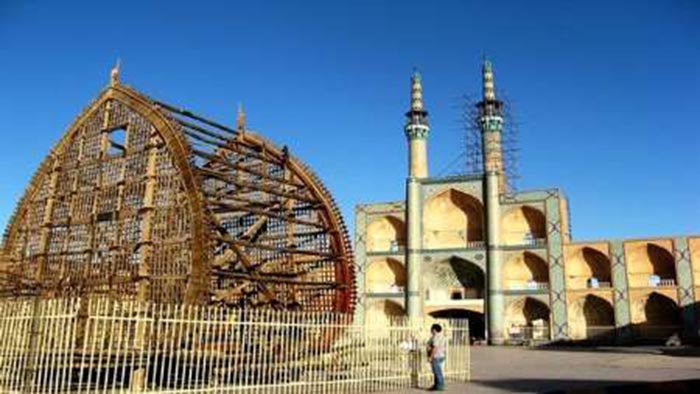
The complex is noted for its symmetrical sunken alcoves. It is a mosque located on a square by the same name. The complex also houses a caravanserai, a tekieh (a place where religious mourning rituals are held), a public bath, a cold water well, and a confectionery, English newspaper Iran Daily reported.
At night, the building is lit up after twilight hours after sunset with orange lighting in the arched alcoves making it a spectacular sight.
During the 1980-88 Iraqi-imposed war against Iran, and Iraq's confrontation with the United States, as well as Afghanistan civil war, many Iraqis and Afghanis established temporary lodgings in Yazd's Amir Chakhmaq Square.
The mosque was named after Amir Jalaleddin Chakhmaq, a governor of Yazd during the Timurid rule (15th-16th century CE). Separate lodging areas for Iraqis and Afghanis are near the mosque. The complex is situated opposite what once was the Yazd Water Museum.
The prominent structure has a three-storey elaborate façade of symmetrical sunken arched alcoves. It is the largest structure in Iran. There are two very tall minarets in the center. The spiral staircase in one of the two minarets is said to give one a feeling of claustrophobia, while it provides a panoramic view of Yazd.
The public bath, in the front of the building is around 600 years old. Arcades have been added recently on its flanks to provide safety from traffic. Only the first floor above the ground level is accessible. There is a shopping mall in the basement of the structure.
The complex includes the three-storey tekieh which used to commemorate the martyrdom of Imam Hussein (PBUH), the third Shia Imam.
There is a nakhl [which symbolizes the coffin (casket) of Imam Hussein (PBUH). It is a scaffold-shaped like a tree leaf] in the corner of tekieh, described as a strong, wooden object with very large metal fixtures and studs. It was venerated to commemorate the anniversary of Ashura - the day in which Imam Hussein (PBUH), his family and supporters were martyred some 14 centuries ago.
According to Vahid Vahdatzad, an architectural historian who has worked extensively on the spatial aspects of Amir Chakhmaq Square, the edifice was built in the 15th century CE by Jalaleddin Amir Chakhmaq, the governor of Yazd during the Timurid era.
This square was established on the north side of an important mosque called the Old Mosque and is known today as Amir Chakhmaq Mosque. According to Vahdatzad, the mosque was also founded by Amir Chakhmaq between 1418 and 1438 CE. The same year the mosque was inaugurated, Haj Qanbar Jahanshahi, who was the subsequent governor, constructed a bazaar and caravanserai at the fringes of the square.
Many parts of the complex fell into disrepair until the 18th century during the Safavid era, when Bahador Khan Shams Yousef Meibodi renovated some sections and reconstructed the caravanserai in the same location. The complex again encountered erosion until the late 19th century when the tekieh was built by Abolqasem Rashti at the entrance of the bazaar.
Most of the changes in Amir Chakhmaq Square were implemented during the rule of the first Pahlavi king, Reza Shah. The northern part of the square, which linked the street to the bazaar, was demolished. It seems the caravanserai was torn down at the same time in order to develop the square in a more orderly rectangular shape.
Nothing remained of the old square then, except the tekieh. The municipality even tried to demolish the tekieh when one of the porticos collapsed, but the archeology office resisted strongly. Instead, they filled the two arcades on both sides in 1963 to prevent further disintegration.

Add new comment